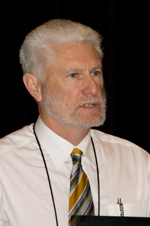Friday General Session
Using DNA in Beef Cattle Selection
Speaking during the Beef Improvement Federation (BIF) symposium’s Friday general session, University of Melbourne (Australia) geneticist Mike Goddard said the gradual unlocking of the beef cattle genome promises greater opportunity for breeders to manipulate genetic variation. DNA testing has already made it easier to select for or against some genetic traits, because they are known to be controlled by single genes. However, Goddard explained that most economically important traits are influenced by many different genes and the environment.

Mike Goddard,
chief scientist, Beef CRC, Australia
“That’s a tiny amount of influence,” Goddard explained. “And hundreds or thousands of SNPs might be needed to explain all of the variation expressed for just one trait.”
Recently, Goddard said, panels of 50,000 SNPs have become available, offering greater opportunity to select for traits beef cattle breeders want to improve. To use these SNPs, their potential effect on important traits must be estimated. From a reference population, cattle are genotyped for the SNPs and measured for the associated traits. Then a prediction equation is derived to estimate a breeding value for each particular trait. The prediction equation is then applied to a different population of animals that have SNP genotypes but no phenotypic information to calculate a molecular breeding value (MBV). The MBV is combined with the traditional expected progeny difference (EPD) value, creating a new and more accurate genomic EPD (GEPD).
It should be more accurate, but Goddard said obtaining a prediction equation that accurately predicts breeding value from SNP genotypes has been difficult, because a prediction equation that works in one breed or herd may not work in other breeds and herds. The answer, he said, will likely come from estimating prediction equations from very large reference populations that include several breeds, and then testing or validating the prediction equations across large populations involving several breeds.
The industry is attempting to utilize the first generation of genomic EPDs. In years to come, Goddard expects many animals will have DNA genotypes, and the methods used to calculate EPDs will change drastically, with results offering improved accuracy.
“Genomic technology will keep getting better,” Goddard added. “We should have 300,000 or more SNPs available to us in the near future, and costs will lessen. DNA profiles, I believe, will become very common and will be used directly in the calculation of EPDs.”
Editor’s Note: This summary was written under contract or by staff of Angus Productions Inc. (API). To request reprint rights contact Shauna Rose Hermel, editor, at 816-383-5270. PowerPoints are posted with permission of the presenter and may not be reproduced in whole or in part without the express permission of the presenter.
The 41st BIF Research Symposium and Annual Meeting was hosted by the California Beef Cattle Improvement Association and the California Cattlemen's Association. For more information, visit www.bifconference.com or www.calcattlemen.org/bif2009.html.



